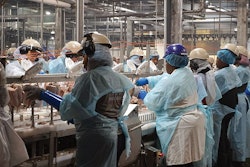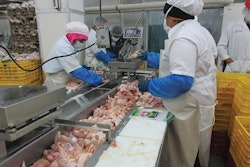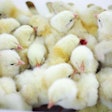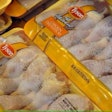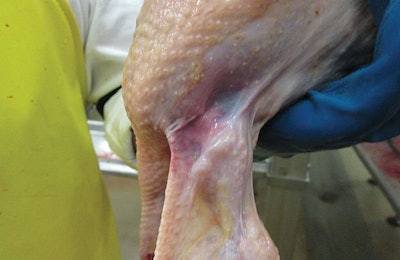
Handling with care should be observed throughout the entire broiler processing operation, but there are a number of actions from harvest through final processing where the risks of the final carcass being rejected increase and where particular attention needs to be paid to minimize yield loss.
Capture with care
Particular care must be taken during pre-slaughter to not rupture the gastrocnemius muscle. If birds are handled roughly during harvesting the risk of it breaking and bleeding increases. Similarly, care must taken not to dislocate the femur.
During harvesting it is important to remember possible impacts on thigh quality. Capturing birds by the legs and carrying as many as possible can lead to femur dislocation, bleeds and bruising.
Broilers’ attempts to escape from stressors can also lead to a deterioration in thigh quality.
Escaping from stressors can lead to birds piling up on each other. It is worth remembering that the upper part of the thigh does not have feather cover and that the skin is exposed, making it more vulnerable to scratching when birds are fleeing sources of stress.
Products can be administered to birds pre-harvest to strengthen the skin; however, capture and caging should always be conducted in such a way as to minimize the stress experienced by the chickens and reducing the risks of harm coming to them.

Careless capture can lead to femur damage which will become apparent once the chicken has been processed. (Eduardo Cervantes López)
Proper shackling, transport to stun
Birds must be hung on the shackles correctly. Both legs must be placed evenly into the shackles and properly adjusted to not cause the birds pain. Once in the shackles, chickens must remain in constant contact with the breast comforter and they are to remain peaceful and relaxed on the way to the stunner.
Birds must not experience pre-shock on the approach to the stun bath. Should this occur, they will lift themselves up while in the shackles and this affects the shoulder resulting in a ring-shaped bruise.
Without proper stunning, birds will move in the bleed tunnel, rising and falling in response to intense pain. This movement can cause dislocation of the wing and, again, results in bruising.
Stunning needs to be carefully managed; for example, the frequency, voltage and amperage of the current and the height of the bath needs to be adjusted to the sex and weight of the birds. If not, then there may be bleeding within the breast muscle.
Skin care
The skin is the body’s largest organ providing functions such as protecting the internal organs, providing thermal insulation, acting as a barrier against the environment, as well as acting as a sensory organ.
There are a number of factors that may result in harm coming to a broiler’s skin and these need to be kept in mind if the skin quality of the finished carcass is to be acceptable.
Today’s birds tend to grow more quickly and their skin may not have had time to become fully resistant. Moreover, there are many areas that may not have full feather cover and are at greater risk of being harmed.
Faster growing birds tend to be heavier and this results in them spending a lot of time lying on the bedding. Should the bedding not be dry, the skin may blister and burn as a result of contact with uric acid.
Nutrition will also affect skin condition, particularly if feed is deficient in certain amino acids.
Changes to the skin can fall into two categories: changes to color and increases in its thickness. In the case of the latter, the skin may develop scabs or have a cratered appearance.
These skin issues should not be confused with poorly managed operations at the processing plant.
For example, a failure to change the plucking fingers on a daily basis will mean that more pressure must be applied to adequately remove feathers and this can damage the skin. Similarly, if the temperature of water used during plucking is too low, follicles will close meaning that, once again, more pressure will need to be applied.

Care must be taken to protect a broiler's skin if rejects are to be kept to a minimum. (Eduardo Cervantes López)

